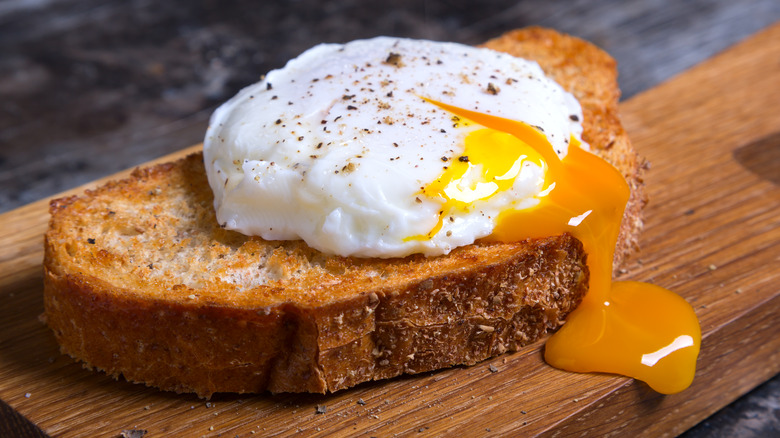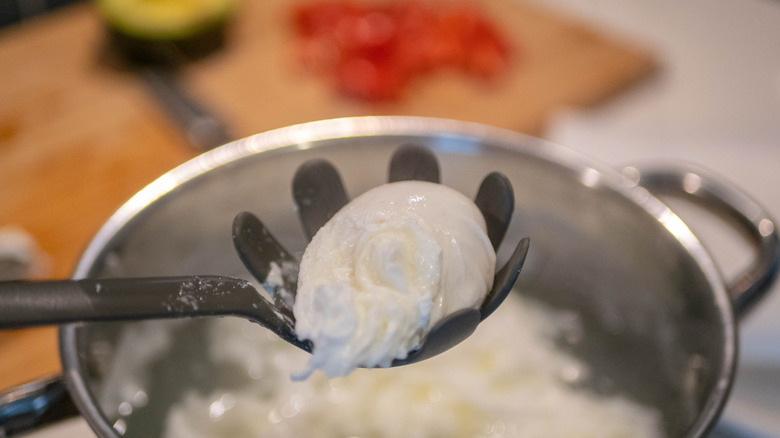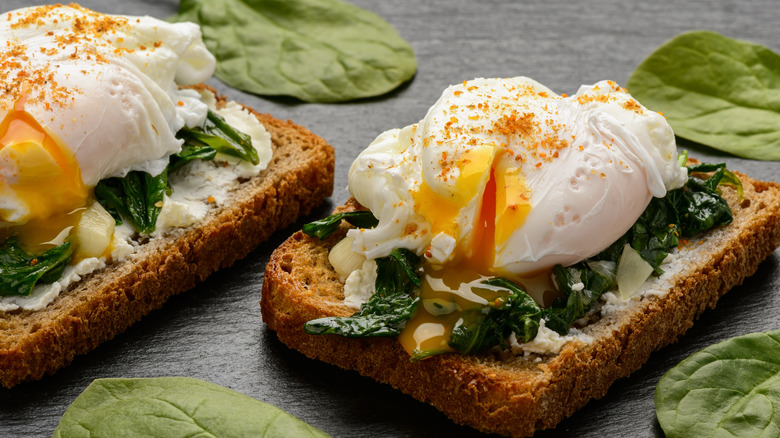Why You Should Make Poached Eggs As Soon As You Buy The Carton
Perfectly poached eggs are truly a treat at breakfast or brunch. Whether they're spilling their soft golden yolks onto Canadian bacon and rich hollandaise in eggs Benedict, or served atop avocado toast, the runny, creamy yolks and firm yet delicate whites make these eggs a delicious addition to any dish. The only problem is that making them can be a little daunting.
Learning how to poach an egg is a great skill for any home to cook to add to their repertoire, but getting the perfect shape, texture, and doneness can be tricky. It's easy to overcook or undercook poached eggs, not to mention the egg might just disintegrate into a wispy mess as soon as it hits the water. The internet is full of tips for avoiding these mishaps, from using water at the right temperature and swirling it to create a whirlpool — which is said to help with shape — to adding vinegar or lemon juice to the water to help the egg solidify. But the best way to avoid any mishaps when poaching eggs starts before cooking: You need to use very fresh eggs.
If you're planning to poach some eggs, do it right after you buy the carton and take it home. Fresher eggs always taste better, and in addition to that, the texture of egg whites change as they get older. It's much easier to successfully poach fresh eggs, resulting in a neater shape with less wispy egg whites floating around in the pot.
The big benefit of fresher eggs
When poaching eggs, you want a neat ball of just-set whites fully encasing a soft yolk. In very fresh eggs, the proteins in the whites are tightly packed together. But as eggs age, the structure of the white changes, which alters the texture. They become more alkaline, which loosens the proteins and prevents them from holding together efficiently. This means that the white of the egg becomes looser, more watery, and much runnier. When you try to poach an older egg, this change in texture causes the white to spread out and turn wispy, rather than forming a tight layer around the yolk.
You can check how fresh an egg is by looking at the Julian date. This is a date found on the carton that tells you when the eggs were packed, and runs from 001 (for January 1 of the year) to 365 (for December 31). Usually, a higher number means fresher eggs. Or, you can use the float test to determine how fresh eggs are. Older eggs develop an air bubble inside their shells, caused by moisture evaporation as they age. Simply pop an egg in a glass of water to determine its age. When eggs are at their freshest, they will naturally lie on their sides, but as they get older, they will start to tilt upright, until they eventually float.
Strain the whites for perfectly poached eggs
Even when using very fresh eggs, you also need the proper technique to poach them successfully. An essential step is to crack each egg into a fine mesh strainer, which strains out the looser, more watery parts of the raw white. A method popularized by Michelin-starred chef Heston Bluenthal, this trick ensures that only the firmest parts of the white wind up in your pot, resulting in a nice, round shape and less wispy strands of egg white all over the place.
Next, the strainer can be used to lower the egg gently into the simmering water. This straining method also means that there's no need to add any vinegar to the water, since the egg will naturally hold its shape, especially if it is fresh to begin with. And if you want to make brunch for a crowd, the good news is that you can poach eggs ahead of time, making for less hassle when it's time to use them in your recipes. Just store them in ice water in the refrigerator after cooking, and then reheat the batch in a hot water bath when you're ready to serve them.



